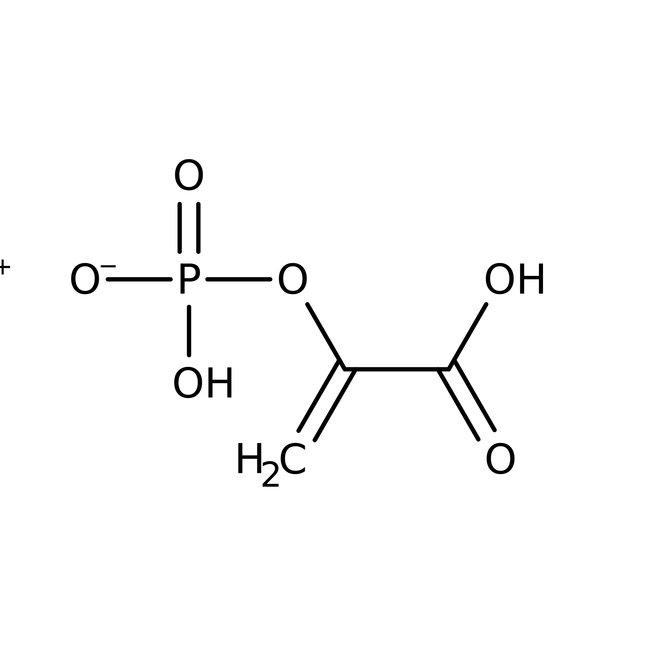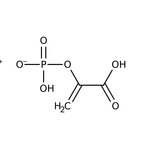Search Thermo Fisher Scientific
Thermo Scientific Chemicals
Phosphoenolpyruvic acid monopotassium salt, 99%
CAS: 4265-07-0 | C3H4KO6P | 206.131 g/mol
| Catalog Number | Quantity |
|---|---|
| ALFB20358.06 | 5 g |
Catalog number ALFB20358.06
View Price:Sign InSign in to see your account pricing. Need an account? Register with us today.
Quantity:
5 g
Specifications
Chemical Name or MaterialPhosphoenol pyruvate monopotassium salt
CAS4265-07-0
Melting Point∽170°C (decomposition)
Recommended StorageStore at -20°C; Store under Nitrogen
EINECS Number224-247-0
View more
Phosphoenolpyruvic acid monopotassium salt is used in glycolysis and gluconeogeneis. It is used for regeneration of ATP from ADP in enzyme-catalyzed syntheses. It is metabolized by an enzyme namely pyruvate kinase to yield pyruvate. It acts as protection against cell injury induced by oxidative stress and against dysfunction in carbohydrate metabolism.
This Thermo Scientific Chemicals brand product was originally part of the Alfa Aesar product portfolio. Some documentation and label information may refer to the legacy brand. The original Alfa Aesar product / item code or SKU reference has not changed as a part of the brand transition to Thermo Scientific Chemicals.
Applications
Phosphoenolpyruvic acid monopotassium salt is used in glycolysis and gluconeogeneis. It is used for regeneration of ATP from ADP in enzyme-catalyzed syntheses. It is metabolized by an enzyme namely pyruvate kinase to yield pyruvate. It acts as protection against cell injury induced by oxidative stress and against dysfunction in carbohydrate metabolism.
Solubility
Soluble in water. Slightly soluble in methanol.
Notes
Hygroscopic. Incompatible with strong oxidizing agents.
Phosphoenolpyruvic acid monopotassium salt is used in glycolysis and gluconeogeneis. It is used for regeneration of ATP from ADP in enzyme-catalyzed syntheses. It is metabolized by an enzyme namely pyruvate kinase to yield pyruvate. It acts as protection against cell injury induced by oxidative stress and against dysfunction in carbohydrate metabolism.
Solubility
Soluble in water. Slightly soluble in methanol.
Notes
Hygroscopic. Incompatible with strong oxidizing agents.
RUO – Research Use Only
General References:
- Used for regeneration of ATP from ADP in enzyme-catalyzed syntheses: J. Org. Chem., 47, 3765 (1982); 50, 1076 (1985); J. Am. Chem. Soc., 107, 7019 (1985).
- Yarman, A.; Schulz, C.; Sygmund, C.; Ludwig, R.; Gorton, L.; Wollenberger, U.; Scheller, F. W. Third Generation ATP Sensor with Enzymatic Analyte Recycling. Electroanalysis 2014, 26 (9), 2043-2048.
- Gauss, D.; Schoenenberger, B.; Wohlgemuth, R. Chemical and enzymatic methodologies for the synthesis of enantiomerically pure glyceraldehyde 3-phosphates. Carbohydr. Res. 2014, 389, 18-24.



